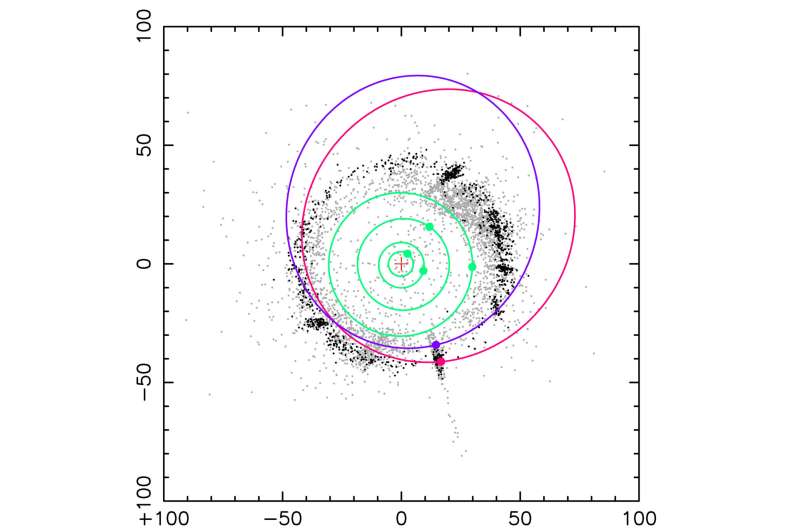The Subaru Telescope's wide and deep imaging observations are contributing information to the New Horizons spacecraft as it moves through the outer solar system. By applying a unique analysis method to images of Kuiper Belt objects taken by the Subaru Telescope's ultra-wide-field camera, objects that have the potential to extend the Kuiper Belt region have been discovered.
What lies beyond the known planets of our solar system? Beyond Neptune, there is the Kuiper Belt, a ring-shaped region of asteroids and other small objects. The area from the Kuiper Belt to the Oort Cloud is called the "outer solar system," but our knowledge is still limited to the regions closer to the sun.
"Looking outside of the solar system, a typical planetary disk extends about 100 au from the host star (100 times the distance between the Earth and the sun), and the Kuiper Belt, which is estimated to extend about 50 au, is very compact.
"Based on this comparison, we think that the primordial solar nebula, from which the solar system was born, may have extended further out than the present-day Kuiper Belt," says Dr. Fumi Yoshida (Industrial Medical University of Japan; Center for Planetary Exploration Research, Chiba Institute of Technology), who led the research.
According to current observational data, the outer edge of the Kuiper Belt appears to be abruptly cut off around 50 au. If this outer edge corresponds to the outer edge of the primordial solar nebula, then the planetary disk of the solar system was born very small.
On the other hand, it is also possible that the outer edge of the Kuiper Belt has been clipped by its outer bodies (such as undiscovered planets). If this is true, observations further out in the Kuiper Belt may reveal a cut-off object, or a second Kuiper Belt.
Finding objects at the outer edges of the solar system and studying their distribution will help us to understand the evolution of the solar system.
NASA's "New Horizons" is a space mission to explore the outer solar system. It had a flyby of the Pluto system in 2015 and Arrokoth, one of the Kuiper Belt objects, in 2019. New Horizons gave us the first glimpse of the surface of an outer solar system object.
After the Arrokoth flyby, the New Horizons' extended mission started, and the Subaru Telescope began helping to find Kuiper Belt objects for the spacecraft to flyby and/or observe.

The search for Kuiper Belt objects using the Subaru Telescope's Hyper Suprime-Cam (HSC) was focused on two HSC fields along the spacecraft's trajectory (combined the two fields cover an area of the sky equivalent to about 18 full moons). In about 30 half-nights of observations, the New Horizons science team (mission team) has so far found more than 240 outer solar system objects.
In this study, a team led by a Japanese researcher analyzed images acquired from the above observations using a different method than the mission team and discovered seven new outer solar system objects.
The results of this research were published in Publications of the Astronomical Society of Japan (PASJ) on May 29, 2024, titled "A deep analysis for New Horizons' KBO search images."
Lead author, Dr. Yoshida, noticed that the HSC observation data, which had been taken at regular intervals with a fixed field of view, could be analyzed with the Moving Object Detection System developed by JAXA, which is normally used to detect near-Earth asteroids and space debris.
This system detects moving objects at a specific velocity by overlaying 32 consecutive images shifted in any direction. It is uniquely designed for high-speed processing (Figure 2). Two of the seven new objects discovered by the team using this detection system have had their approximate orbits determined and have been assigned provisional designations by the Minor Planet Center (MPC) of the International Astronomical Union.
Previous observations have shown that the number of Kuiper Belt objects decreases dramatically beyond about 50 au, so the outer edge of the Kuiper Belt is thought to be about there. However, the semi-major axis of the two objects discovered and provisionally designated are both greater than 50 au (Figure 1; The orbital elements of these objects may somewhat vary as observations accumulate in future, though).
If such discoveries continue, we may conclude that the Kuiper Belt extends even further. Through the collaboration of the Subaru Telescope and New Horizons, which is still traversing the outer solar system, we anticipate the exploration to extend into the deeper regions of the outer solar system, which have not yet been reached by the human eye.
"The mission team's search for Kuiper Belt objects using HSC continues to this day, and a series of papers will be published in the future, mainly by the North American group. This research, the discovery of sources with the potential to expand the Kuiper Belt region using a method developed in Japan and led by Japanese researchers, serves as a precursor to those publications," says Dr. Yoshida.
More information: Fumi Yoshida et al, A deep analysis for New Horizons' KBO search images, Publications of the Astronomical Society of Japan (2024). DOI: 10.1093/pasj/psae043
Provided by Subaru Telescope



